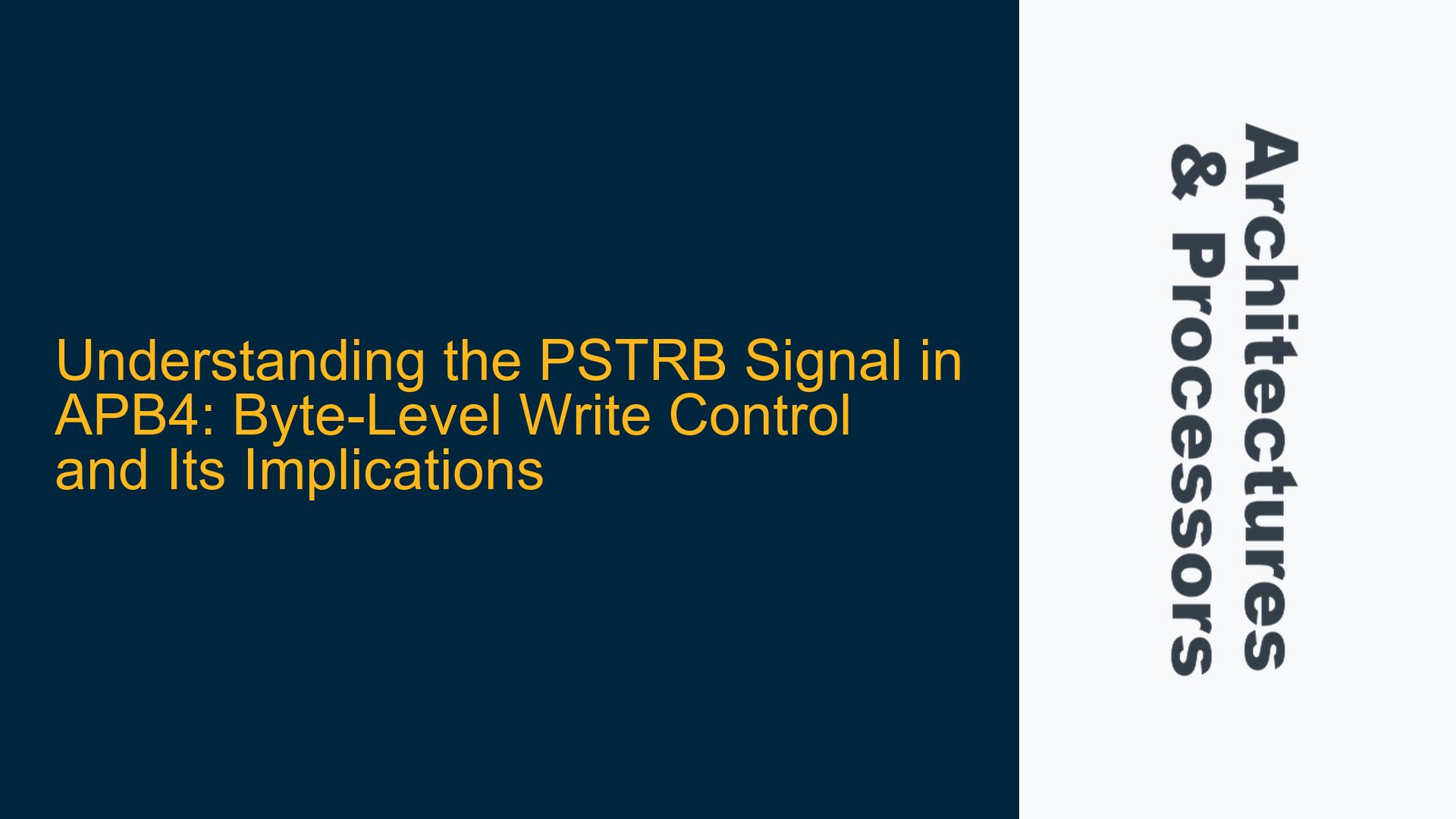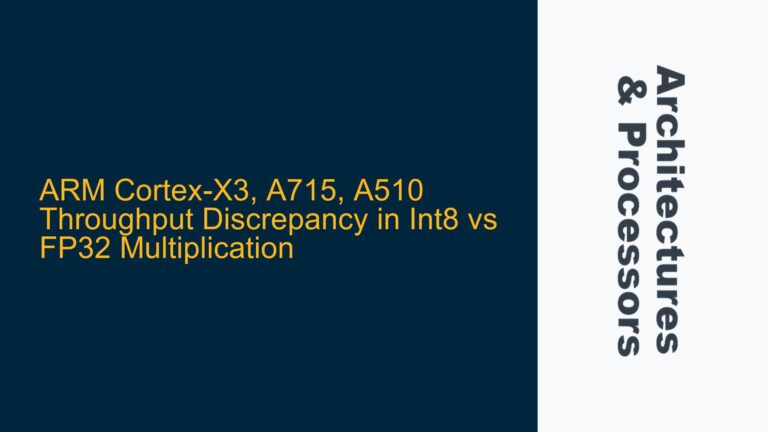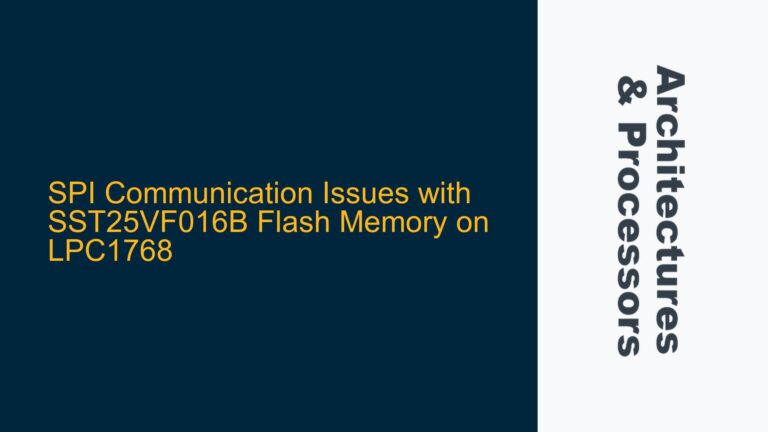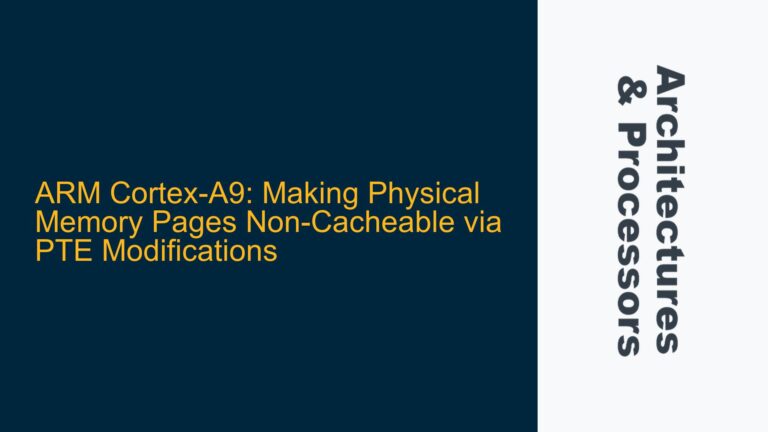PSTRB Signal Functionality in APB4: Byte-Level Write Control
The PSTRB signal in the APB4 protocol is a critical component for managing write operations at the byte level. It is a 4-bit signal that corresponds to the 32-bit write data bus (PWDATA) in a typical APB4 implementation. Each bit in the PSTRB signal controls the validity of a specific byte lane in the PWDATA bus. For example, PSTRB[0] corresponds to PWDATA[7:0], PSTRB[1] corresponds to PWDATA[15:8], PSTRB[2] corresponds to PWDATA[23:16], and PSTRB[3] corresponds to PWDATA[31:24]. When a specific PSTRB bit is set to ‘1’, it indicates that the corresponding byte lane in PWDATA contains valid data that should be written to the target register or memory location. Conversely, a ‘0’ indicates that the corresponding byte lane should be ignored during the write operation.
The primary purpose of the PSTRB signal is to enable fine-grained control over write operations, allowing the system to update only specific bytes within a 32-bit word without affecting the other bytes. This capability is particularly useful in scenarios where partial updates to a register or memory location are required, such as when modifying specific fields within a configuration register or updating individual bytes in a data buffer. By using the PSTRB signal, the system can avoid unnecessary read-modify-write cycles, which can improve performance and reduce power consumption.
The PSTRB signal is also essential for ensuring data integrity during write operations. In a system where multiple masters may be accessing shared resources, the ability to control which bytes are written helps prevent unintended modifications to critical data. For example, if one master is updating a specific field in a shared register while another master is updating a different field, the PSTRB signal ensures that each master’s updates are applied only to the intended byte lanes, avoiding data corruption.
Why PSTRB is a 4-Bit Signal: Alignment with PWDATA Bus Width
The PSTRB signal is implemented as a 4-bit signal to align with the typical 32-bit width of the PWDATA bus in APB4. This alignment ensures that each byte lane in the PWDATA bus has a corresponding write strobe bit in the PSTRB signal. The relationship between the PSTRB bits and the PWDATA bus is defined by the APB4 specification, which states that PSTRB[n] corresponds to PWDATA[(8n + 7):(8n)]. This means that PSTRB[0] controls the least significant byte (LSB) of PWDATA, while PSTRB[3] controls the most significant byte (MSB).
The 4-bit width of the PSTRB signal is not arbitrary; it is directly tied to the maximum width of the PWDATA bus in APB4. While the APB4 protocol allows for narrower data bus widths (e.g., 16-bit or 8-bit), the 32-bit width is the most common implementation. In systems with narrower data buses, the width of the PSTRB signal can be reduced accordingly. For example, in a system with a 16-bit PWDATA bus, only two PSTRB bits (PSTRB[1:0]) would be required, as there are only two byte lanes to control. Similarly, in an 8-bit system, only one PSTRB bit (PSTRB[0]) would be needed.
The decision to use a 4-bit PSTRB signal for a 32-bit PWDATA bus is driven by the need to support byte-level write operations efficiently. Without the PSTRB signal, the system would have to rely on read-modify-write cycles to update specific bytes within a 32-bit word, which would increase complexity and reduce performance. By providing a dedicated write strobe signal for each byte lane, the PSTRB signal simplifies the design of the write logic and enables more efficient data transfers.
Addressing Unaligned Transfers and APB4 Limitations
One of the key limitations of the APB4 protocol is its lack of support for unaligned transfers. Unlike more advanced protocols like AXI, which provide mechanisms for handling unaligned accesses (e.g., using the AWSIZE signal), APB4 is designed to be as simple as possible, and it assumes that all transfers are aligned to the width of the data bus. This means that in a typical 32-bit APB4 system, all addresses must be aligned to 4-byte boundaries (i.e., the address must be divisible by 4). Similarly, in a 16-bit system, addresses must be aligned to 2-byte boundaries, and in an 8-bit system, addresses must be aligned to 1-byte boundaries.
The lack of support for unaligned transfers in APB4 is a deliberate design choice aimed at minimizing the complexity of the protocol. By requiring aligned transfers, APB4 simplifies the design of the address decoding logic and reduces the overhead associated with handling misaligned accesses. However, this limitation can pose challenges in systems where unaligned transfers are necessary, such as when interfacing with peripherals that have non-standard register sizes or when dealing with data structures that are not aligned to the natural boundaries of the data bus.
In such cases, the system designer must implement additional logic to handle unaligned transfers outside of the APB4 protocol. This typically involves breaking down the unaligned transfer into multiple aligned transfers and using the PSTRB signal to control which bytes are written in each transfer. For example, if a 32-bit write operation needs to be performed at an address that is not aligned to a 4-byte boundary, the system can split the operation into two aligned transfers: one for the lower part of the data and one for the upper part. The PSTRB signal can then be used to ensure that only the relevant bytes are written in each transfer.
While this approach can work, it adds complexity to the system and may impact performance, especially if unaligned transfers are frequent. Therefore, it is generally recommended to avoid unaligned transfers in APB4-based systems whenever possible. If unaligned transfers are unavoidable, careful consideration must be given to the design of the address decoding logic and the handling of the PSTRB signal to ensure that data integrity is maintained and that performance is not adversely affected.
Practical Considerations for PSTRB Signal Implementation
When implementing the PSTRB signal in an APB4-based system, several practical considerations must be taken into account to ensure correct operation and optimal performance. First, the system designer must ensure that the PSTRB signal is correctly synchronized with the PWDATA bus and the write enable signal (PWRITE). The PSTRB signal must be valid at the same time as the PWDATA bus and must remain stable throughout the write cycle. Any delay or instability in the PSTRB signal can lead to incorrect write operations, resulting in data corruption.
Second, the system designer must consider the impact of the PSTRB signal on the timing of the write operation. In a typical APB4 system, the write operation is completed in a single clock cycle, and the PSTRB signal must be valid during this cycle. If the system uses pipelining or other timing optimizations, care must be taken to ensure that the PSTRB signal is correctly aligned with the pipeline stages and that it does not introduce additional latency.
Third, the system designer must ensure that the PSTRB signal is correctly handled in systems with multiple masters or peripherals. In a multi-master system, each master may have its own PSTRB signal, and the system must ensure that the correct PSTRB signal is used for each write operation. Similarly, in a system with multiple peripherals, the system must ensure that the PSTRB signal is correctly routed to the target peripheral and that it is not inadvertently applied to other peripherals.
Finally, the system designer must consider the impact of the PSTRB signal on the verification and testing of the system. The PSTRB signal introduces additional complexity to the write logic, and it must be thoroughly verified to ensure that it operates correctly under all possible conditions. This includes testing the PSTRB signal with different combinations of byte lane enables, as well as testing its behavior in edge cases, such as when all PSTRB bits are set to ‘0’ or when the PSTRB signal is unstable.
Conclusion
The PSTRB signal in APB4 is a powerful tool for enabling byte-level write control in 32-bit systems. By providing a dedicated write strobe signal for each byte lane, the PSTRB signal simplifies the design of the write logic and enables more efficient data transfers. However, the use of the PSTRB signal also introduces additional complexity, particularly in systems with multiple masters or peripherals, and it must be carefully implemented and verified to ensure correct operation. By understanding the functionality of the PSTRB signal and its relationship to the PWDATA bus, system designers can leverage its capabilities to optimize their APB4-based systems and achieve better performance and data integrity.






